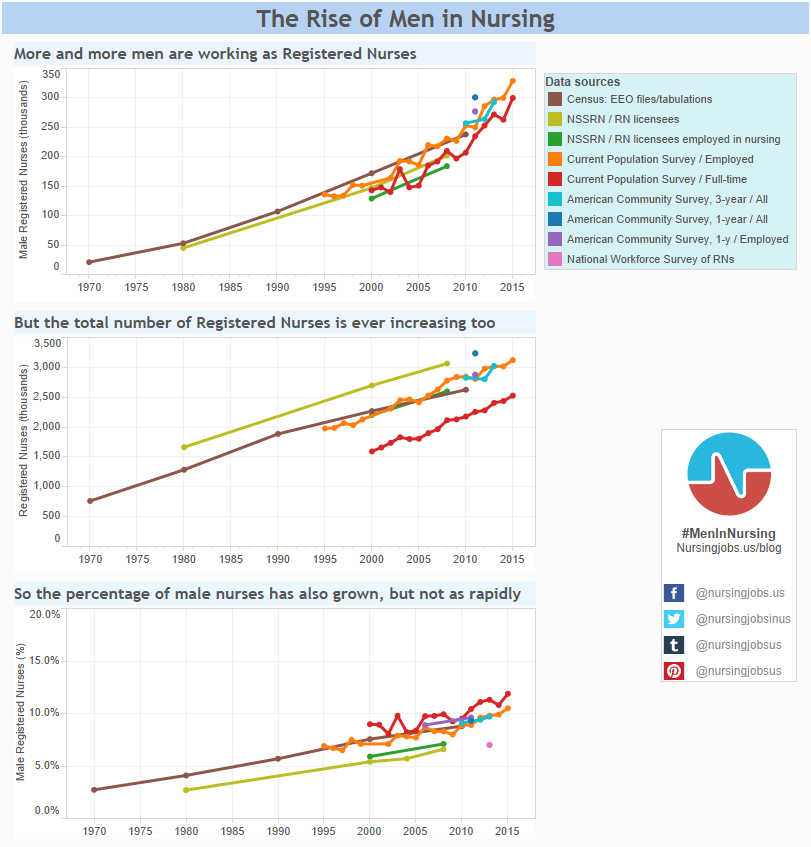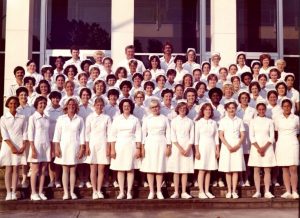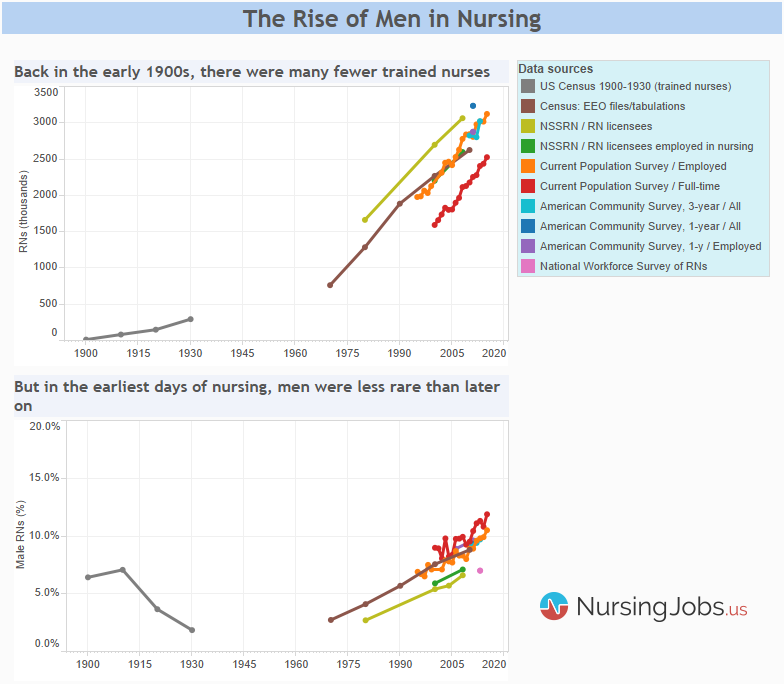There are probably as many as 300,000 male Registered Nurses in the United States – although, as we found out in our last post on #MenInNursing, what the exact number is really depends on whom you ask. What we know for sure is that the number has been steadily rising over the years. Just two generations ago, there were fewer than 50,000 men who worked as RNs. They were genuinely rare. These days, there are six times as many.
While the number of male RNs has grown steadily, however, the total number of people who are employed as Registered Nurses has gone up significantly as well. The U.S. is a more populous country than it was, with one and a half times as many people in the workforce as in 1980. Both the health care industry in general and the nursing profession specifically have gone through major transformations. Back in 1980 there were about 1.5 million RNs in the U.S. Now the number is roughly double that, and the job market for RNs is still booming. According to the Equal Employment Opportunity (EEO) tabulation of American Community Survey data from 2006-2010, around one in thirty employed American women works as a Registered Nurse.
“around one in thirty employed American women works as a Registered Nurse”
As the charts below illustrate, this means that the percentage of male nurses has grown much more slowly than the absolute numbers would suggest. Two generations ago, men made up less than 3% of all Registered Nurses. It would have taken over 5,000 new male nurses every year just to keep that relative share at 3%. As it is, the percentage has grown incrementally, only reaching 7-10% in recent years.

Why do these charts look all squiggly? As we already saw in our previous post, there is no one authoritative source on how many nurses there are in any given year. It all depends on which source you trust most. For example, every time it was conducted, the National Sample Survey of Registered Nurses (NSSRN) found fewer male nurses than the various surveys by the U.S. Census Bureau.
“Men have made relatively little headway in other traditionally female-dominated professions as well.”
The slow growth of the percentage of male RNs is not entirely exceptional. Men have made relatively little headway in other traditionally female-dominated professions as well. According to the Census Bureau’s EEO tabulations, the percentage of male cashiers, for example, rose from 16% to 25% between 1970 and 2006-2010. The percentage of male dental assistants barely budged at all in those four decades, from 2.1% to 3.7%.
Women’s progress in traditionally male-dominated occupations has been much more impressive, including in the health care sector. Few professions have changed as much as pharmacists, where women have gone from 12% of the workforce to 53%. Women’s representation among physicians and surgeons has increased from 10% to 32% over the same time. (They still make up the same, tiny 2% of electricians as in 1970, though.)
The rise of men in nursing: from the 1970s to now

Back in the 1970s, there were still nursing schools which refused to admit male students. It was only in 1982 that the Supreme Court ended this practice once and for all, when it ruled in a narrow 5-to-4 vote on the landmark case Mississippi University for Women v. Hogan. Newly appointed Justice Sandra Day O’Connor wrote the majority opinion. “Rather than compensate for discriminatory barriers faced by women,” she wrote, the university’s “policy of excluding males from admission to the School of Nursing tends to perpetuate the stereotyped view of nursing as an exclusively woman’s job”. Moreover, by ensuring that more women than men were able to find places in nursing schools, the school’s policy made “the assumption that nursing is a field for women a self-fulfilling prophecy.”
Many things have changed now. “Schools are now actively pursuing higher male enrollment in their nursing programs,” the U.S. Census Bureau’s report on Men in Nursing Occupations observed. There have been campaigns specifically focused on recruiting more men into the profession. Eager to compensate for that “stereotyped view of nursing as a woman’s job,” the creators resorted to hyper-masculine imagery to do so. A poster campaign that was initially designed by the Oregon Center for Nursing in 2002, with the slogan “Are You Man Enough.. To Be A Nurse”, was redeployed as far away as Virginia and Florida and as late as 2008. A later campaign, 20×20: Choose Nursing, used similar macho themes to attract men to nursing as a profession.
“I’ve gone from taking lives to saving them, and for me that was something I needed”
One out of six respondents to a Bernard Hodes Group survey of male RNs switched to nursing from military service. The Health Resources and Services Administration (HRSA) funds a Veterans’ Bachelor of Science Degree in Nursing at 20 nursing schools to help veterans become nurses. A male RN interviewed by Healthline, John Lanning, explained how a marine combat veteran and martial arts instructor like him made the switch: “I’ve gone from taking lives to saving them, and for me that was something I needed”.

There’s a number of reasons why nursing should be a more popular career choice for men, too. The most recent NSSRN found that 29% of licensed RNs was “extremely satisfied” with their job, and an additional 52% said they were “moderately satisfied”. Nurses have consistently been the top-rated profession on honesty and ethnical standards, according to Gallup data. A survey by the American Association of Colleges of Nursing last year found that 61% of new BSN graduates at nursing schools already had a job offer at the time of their graduation (thanks to especially high rates in the South and Midwest), while 90% had one within half a year.
In the Healthline article mentioned above, a RN called Travis Grimm “said he expects more men will go into nursing for the good pay [and] competitive benefits”. One of the nurses who was featured in the “Are You Man Enough..” campaign, the intensive-care nurse and former Navy Seal Walter Moore Jr., pointed to the salaries as well: “Show me the money. That works pretty well.”
The upward trend in the share of male RNs is clear. For example, according to the NSSRN, male RNs made up 6.2% of employed RNs who were licensed before 2000, but 9.6% of those licensed in 2000 or later. This way, men become less rare especially among younger nurses. According to data from the 2011 American Community Survey, men constituted 10-11% of RNs under 45, and just 7% of those aged 55-65. Data from nursing schools point to continued, slight growth: men made up 11.7% of the students enrolled in baccalaureate and master’s nursing programs last year, according to the American Association of Colleges of Nursing. But progress is undeniably slow. So how did men mostly get locked out of the profession in the first place?
How did nursing become a traditionally female profession?
It wasn’t always like this. During the Civil War, for example, “about half of the people who contracted to provide nursing to the Union soldiers were men,” according to Men in Nursing: History, Challenges and Opportunities. The most famous was Walt Whitman, who wrote about it in the poem “The Wound Dresser”. In their book Saving Lives: Why the Media’s Portrayal of Nursing Puts Us All at Risk, Sandy Summers and Harry Jacobs Summers went back much further still to observe that a school for male caregivers was established in India in the third century B.C.E. — but they noted that “modern nursing has struggled from the beginning with its gender imbalance”.

In World War 1, some male nurses with the same training and education as the women of the Nurse Corps were classified as orderlies and paid half the salary because the Nurse Corps was only open to women, and would remain so until after the Korean War. This had less to do with the military specifically than with how gender roles came to be policed in modern nursing in general. For that, apparently, you have to go back to Florence Nightingale.
“The formation of the modern profession around the Nightingale model is seen by many to be the principle reason that nursing has been portrayed as being the preserve of women,” Tom O’Connor wrote. “This feminization of nursing stemmed from Nightingale’s belief that men were not suited to nursing and that it was a natural disposition for a woman to be a nurse,” he added. Nightingale apparently wrote that men’s “hard and horny” hands were not suited “to touch, bathe, and dress wounded limbs, however gentle their hearts may be”.
According to Florence Nightingale, men’s “hard and horny” hands were not suited “to touch, bathe, and dress wounded limbs, however gentle their hearts may be”.
Writing in Nurse Educator, Ann Strong Anthony agreed with that analysis. “The feminine roots of nursing were strengthened 150 years ago as the profession began to organize around principles espoused by Florence Nightingale”. On the one hand, Nightingale’s “emphasis on hygiene and environment, careful data collection and analysis, and her standards for character and performance” laid the foundations for turning nursing from “low status work” to a scrupulous profession, and her successes helped make nursing “a respectable career option for unmarried women”. On the other hand, as she elaborated in another article, “men were excluded from the training programs advocated by Nightingale. [..] By the beginning of the twentieth century, there were only two training programs for men in the United States. These programs focused on clinical areas acceptable for male participation, such as psychiatry and urology.”

Nightingale’s advocacy for nursing paved the way for a new image of what a good nurse should be: “nurturing, domestic, humble, and self-sacrificing.” And as “nursing evolved into a stereotyped female role,” Anthony wrote, men became almost fully excluded, and their historical contribution forgotten. It did take a while, though. Historical data from the U.S. Census shows that back in 1900-1910, 7% of nurses were still male. But as nursing entered the modern age and the number of “trained nurses” shot up from just twelve thousand in 1900 to 82 thousand in 1910 and 294 thousand in 1930, the number of male nurses stagnated and their percentage share dropped to less than 2%. At that point, there were more men employed as piano and organ tuners, or as hostlers and stablehands, than as trained nurses. It would take half a century before the percentage would start recovering.
Coming up: So why are there still relatively few male RNs?
We’ve explored how many male nurses there are, and how their proportion has waned and waxed over time, but really, why are there still so few? That’s a complex question with many answers, but we’ll be probing a few of them in an upcoming post on #MenInNursing.
